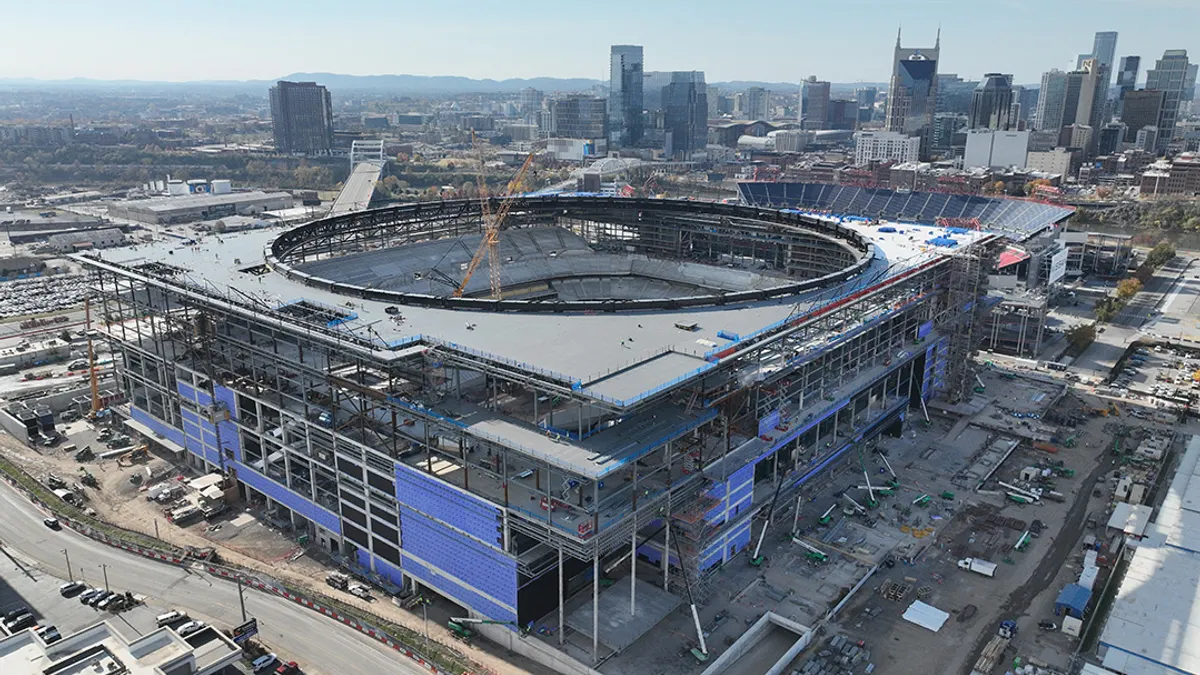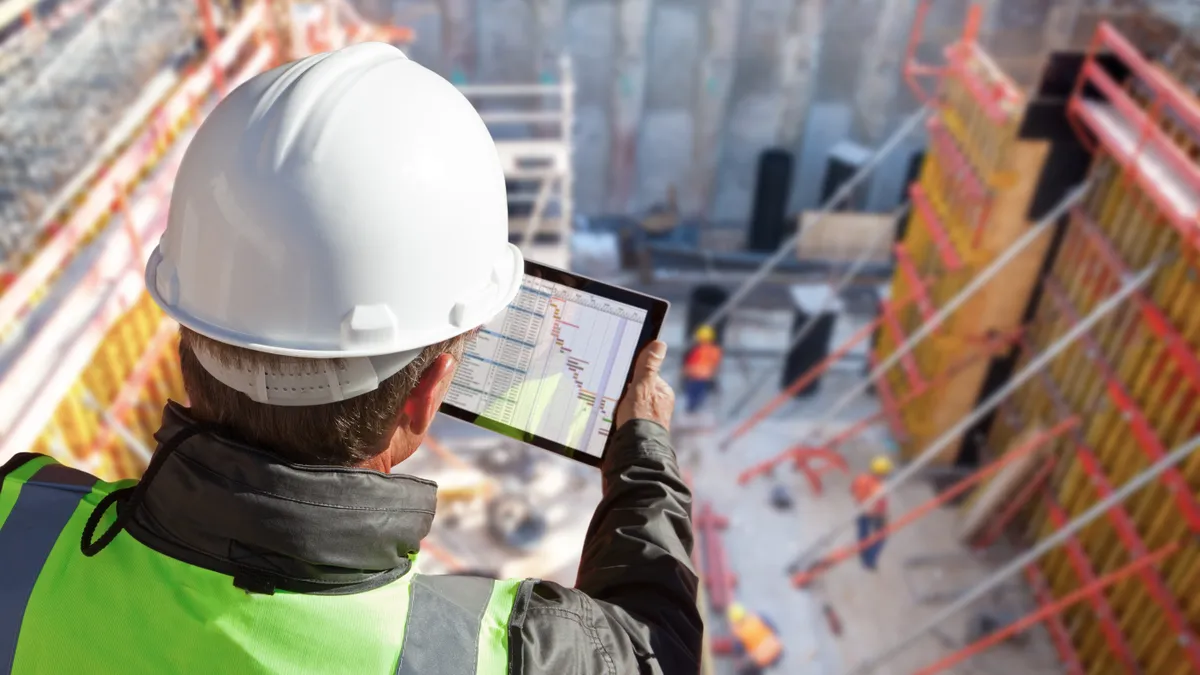Editor's Note: This piece was written by Casey Talon, a principal research analyst contributing to Navigant Research’s Building Innovations program. The opinions represented in this piece are independent of Construction Dive's and Smart Cities Dive's views.
Artificial intelligence (AI) is technology that learns. This concept encompasses machines that take in continuous data and adapt for perpetual evolution from the objective they were designed to achieve. Today, AI has captured mindshare and headlines, claiming market disruption across industries ranging from trucking to shopping.
AI is not a new discipline of computer science and not even completely new in applications for buildings. Today, however, three significant shifts in the market are positioning AI to transform aspects of commercial buildings management.
1. Rapid adoption of IoT opens the door to AI in buildings
Some may argue that the Internet of Things (IoT) and AI are the same in that they are both just headline-grabbing buzzwords. However, when the two topics are focused on applications for specific industries, their relevance as cost-effective investments for business improvement becomes clear. For example, IoT is a framework that produces cost-effective technologies and introduces new approaches to facilities management. Inexpensive wireless sensors, controllers, and gateways can be the hardware backbone to collect and communicate data about equipment operations and space use in commercial buildings. Cloud-based analytics can then translate this data into a multitude of metrics that align with specific business goals.
The idea of ongoing IoT-enabled facility improvement is the latest characterization of the intelligent building. The IoT platform enables the analytics and services that provide businesswide improvements — cost, comfort, and even sustainability. There is a broad spectrum of capabilities under the umbrella of intelligent building solutions — from dashboards that present data about systems operation and the associated costs, to sophisticated analytics (this is where AI comes in) that utilize algorithms to predict those systems’ performance over time. Once the IoT framework is established, AI can enable autonomous improvements to operations within a facility — including heating, cooling and lighting. Here are two examples of how specific types of AI can deliver benefits to commercial building owners:
- Machine learning is gaining traction in the intelligent buildings market starting with HVAC optimization offerings. As customers look to position their facilities as smart assets, machine learning can become a powerful tool for optimizing their equipment performance to manage energy loads and even orchestrate between supply and demand to participate in the evolving energy infrastructure. Navigant Research has been characterizing the evolution of the relationship between supply and demand as the Energy Cloud. Commercial buildings have an important role to play in this new paradigm, and machine learning can enable the opportunity.
- Speech recognition technology can facilitate the real-time sharing of information about the physical environment, including equipment performance or emergency situations. Information from an individual facility can become one of many data streams into a broader application for safety, transportation, or environmental programs when aggregated across local facilities. For example, a tenant could request to reserve a conference room with presentation lighting by speaking aloud.
2. Customers expect technology-enabled convenience
Customers expect the same comfort, convenience and productivity tools they rely on in their personal lives to be accessible in their work life. Furthermore, businesses expect that technology can meet their employees’ expectations to keep and retain the best staff while, at the same time, meet the expectations of their shareholders. What this means is that building owners face a new sort of upward pressure to invest in technology.
AI can help address these shifting pressures on building owners with new solutions that deliver customer satisfaction and improve energy efficiency to reduce costs and promote sustainability. A few examples include:
- Chatbots for real-time customer service
- Speech recognition to make maintenance and repairs teams more efficient
- Predictive analytics to optimize operations and maintenance procedures to minimize business disruption from equipment malfunctions or failures
- Image recognition to make commercial buildings safer and cleaner
3. AI can bolster building owners' top line
There are unique, top-line opportunities for digital buildings. The connectivity of systems, access to real-time data, and continuous automated improvement give these commercial facilities new avenues to optimize energy use, occupant engagement, and profitability. Technical capabilities presented by incorporating new intelligent building controls create opportunities to generate new revenue streams because of the way the intelligent building can be used as an energy asset and data hub.
Intelligent buildings, for example, can be harnessed to balance the grid by managing demand through automated demand response. There is also the opportunity to harness commercial buildings as energy assets in new ways — such as a source of thermal storage. Technology deployment is essential to leveraging commercial buildings as these sorts of flexible energy assets.
The intelligent building can also deliver new value to building owners if positioned as a data hub for digital business stakeholders. For example, in the smart cities context, intelligent buildings can aggregate, analyze and share data that provides value to public safety, environmental/climate change and transportation initiatives. The value of this collective control and optimization, in the smart city illustration, is that it can also apply to enterprise customers that own or manage portfolios of facilities. The ability to track and analyze the flow of people, vehicles and environmental conditions, in real-time, offers invaluable data for the smart city.
Making AI a reality in commercial buildings
The IoT market promotes low-cost infrastructure for data acquisition, communications and analytics — the foundation that enables the deployment of intelligent building applications for the commercial facility. Building owners and operators have been realizing the benefits of intelligent building investments through software applications that transform real-time data into information that directs specific changes to operations. These offerings can range from dashboards and automated alert systems to fully integrated automated HVAC and lighting control solutions. AI offers the next frontier in the sophistication of intelligent building solutions by adding embedded learning to analytics and machines for continuous system improvement.





















